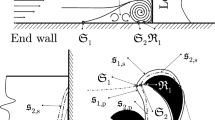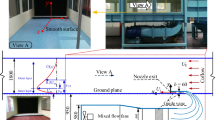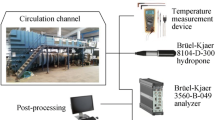Abstract
Flow and heat transfer characteristics over flat, concave and convex surfaces have been investigated in a low speed wind tunnel in the presence of adverse and favourable pressure gradients (k), for a range of –3.6 × 10–6 ≤ k ≤ +3.6 × 10–6. The laminar near zero pressure gradient flow, with an initial momentum thickness Reynolds number of 200, showed that concave wall boundary layer was thinner and heat transfer coefficients were almost 2 fold of flat plate values. Whereas for the same flow condition, thicker boundary layer and 35% less heat transfer coefficients of the convex wall were recorded with an earlier transition. Accelerating laminar flows caused also thinner boundary layers and an augmentation in heat transfer values by 28%, 35% and 16% for the flat, concave and convex walls at k = 3.6 × 10–6. On the other hand decelerating laminar flows increased the boundary layer thickness and reduced Stanton numbers by 31%, 26% and 22% on the flat surface, concave and convex walls respectively. Turbulent flow measurements at k = 0, with an initial momentum thickness Reynolds number of 1100, resulted in 30% higher and 25% lower Stanton numbers on concave and convex walls, comparing to flat plate values. Moreover the accelerating turbulent flow of k = 0.6 × 10–6 brought about 29%, 30% and 24% higher Stanton numbers for the flat, concave and convex walls and the decelerating turbulent flow of k = –0.6 × 10–6 caused St to decrease up to 27%, 25% and 29% for the same surfaces respectively comparing to zero pressure gradient values. An empirical equation was also developed and successfully applied, for the estimation of Stanton number under the influence of pressure gradients, with an accuracy of better than 4%.









Similar content being viewed by others
Abbreviations
- Cp :
-
constant pressure specific heat, J/kgK
- Cf :
-
skin friction factor, dimensionless
- h:
-
convective heat transfer coefficient, W/m2K
- H:
-
shape factor
- k:
-
pressure gradient parameter [(ν/U2)(dU/dx)], dimensionless
- kx :
-
streamwise pressure gradient [(xp/U)(dU/dxp)], dimensionless
- qF, qo :
-
flow-on and flow-off powers, W/m2
- Rex :
-
streamwise distance Reynolds number, dimensionless
- Re :
-
momentum thickness Reynolds number, dimensionless
- St:
-
Stanton number, dimensionless
- Sto :
-
Stanton number without longitudinal pressure gradient, dimensionless
- Stp :
-
Stanton number with longitudinal pressure gradient, dimensionless
- Tw :
-
wall temperature, °C
- To :
-
free stream temperature, °C
- U:
-
mean velocity, free stream velocity, m/s
- x,y,z:
-
streamwise, pitch wise and spanwise directions, mm
- xl :
-
unheated starting length, mm
- xp :
-
pressure imposed streamwise length, mm
- δ:
-
boundary layer thickness, mm
- ν:
-
kinematic viscosity, m2/s
- ρ:
-
density, kg/m3
- θ:
-
momentum thickness, mm
References
Abu-Ghannam BJ; Shaw H (1980) Natural transition of boundary layers-the effects of turbulence, pressure gradient and flow history. Mech Eng Sci 22: 213–228
Crane RI; Sabzvari J (1989) Heat transfer visualization and concave-wall laminar boundary layers. J Turbomachinery-Transactions ASME 111: 51–56
Umur H (1994) Concave wall heat transfer characteristics with longitudinal pressure gradients and discrete wall jets. JSME Int J 37: 403–412
Gostelaw JP; Blunden AR; Walker GJ (1994) Effects of free-stream turbulence and adverse pressure gradients on boundary layer transition. J Heat Transfer-Transactions ASME 116: 392–404
Zhang DH; Winoto SH; Chew YT (1995) Measurement in laminar and transitional boundary-layer flows on concave surface. Int J Heat Fluid Flow 16: 88–98
Zhou D; Wang T (1996) Combined effects of elevated free-stream turbulence and streamwise acceleration on flow and thermal structures in transitional boundary layers. Exp Thermal Fluid Sci 12: 338–351
Volino RJ; Simon TW (1997) Boundary layer transition under high free-stream turbulence and strong acceleration conditions: part 2-turbulent transport results. J Heat Transfer-Transactions ASME 119: 427–432
Umur H; Karagoz I (1999) An investigation of external flows with various pressure gradients and surfaces. Int Com Heat Mass Trans 26: 411–419
Sturgis JC; Mudawar I (1999) Single-phase heat transfer enhancement in a curved, rectangular channel subjected to concave heating. Int J Heat Mass Trans 42: 1255–1272
Wright L; Schobeiri MT (1999) The effect of periodic unsteady flow on aerodynamics and heat transfer on a curved surface. J Heat Transfer-Transactions ASME 121: 22–33
Umur H (2000) Flow and heat transfer with pressure gradients, Reynolds number and surface curvature. Int Com Heat Mass Trans 27: 397–406
Muck KC; Hoffman PH; Bradshaw P (1985) The effect of convex surface curvature on turbulent boundary layers. J Fluid Mech 161: 347–369
Wang T; Simon TW (1987) Heat transfer and fluid mechanics measurements in transitional boundary layers on convex-curved surfaces. J Turbomachinery-Transactions ASME 109: 443–451
Taylor RP; Coleman HW; Hosni MH; Love PH (1989) Thermal boundary condition effects on heat transfer in the turbulent incompressible flat plate boundary layer. Int J Heat Mass Trans 32: 1165–1174
Plesniak MW; Mehta RD; Johnston JP (1994) Curved two-stream turbulent mixing layers: three dimensional structure and streamwise evolution. J Fluid Mech 270: 1–50
Rivir RB; Johnston JP; Eaton JK (1994) Heat transfer on a flat surface under a region of turbulent separation. J Turbomachinery-Transactions ASME 116: 57–62
Inagaki K; Aihara Y (1995) An experimental study of the transition region of the boundary layer along a concave wall. European J Mech B/Fluids 14: 143–168
Webster DR; Degraaff DB; Eaton JK (1996) Turbulence characteristics of a boundary layer over a two-dimensional bump. J Fluid Mech 320: 53–69
Kestoras MD; Simon TW (1997) Turbulent transport measurements in a heated boundary layer: combined effects of free-stream turbulence and removal of concave curvature. J Heat Transfer-Transactions ASME 119: 413–419
Ligrani PM; Hedlung CR (1998) Transition to turbulent flow in curved and straight channels with heat transfer at high Dean numbers. Int J Heat Mass Trans 41: 1739–1748
Cebeci T; Bradshaw P (1984) Physical and computational aspects of convective heat transfer. Springer-Verlag, New York
Cheng KC; Obata T; Gilpin RR (1988) Buoyancy effects on forced convection heat transfer in the transition regime of a horizontal boundary layer heated from below. J Heat Transfer-Transactions ASME 110: 596–603
Turner AB; Hubbe-Walker SE; Bayley FJ (2000) Fluid flow and heat transfer over straight and curved rough surfaces. Int J Heat Mass Trans 43: 251–262
Mayle RE; Blair MI; Kopper FG (1979) Turbulent boundary layer heat transfer on curved surfaces. J Heat Transfer-Transactions ASME 101: 521–525
So RM; Mellor GL (1975) Experiment on turbulent boundary layers on a concave wall. Aeronaut Quart 26: 25–40
Author information
Authors and Affiliations
Corresponding author
Rights and permissions
About this article
Cite this article
Ozalp, A.A., Umur, H. An experimental investigation of the combined effects of surface curvature and streamwise pressure gradients both in laminar and turbulent flows. Heat and Mass Transfer 39, 869–876 (2003). https://doi.org/10.1007/s00231-003-0413-4
Received:
Published:
Issue Date:
DOI: https://doi.org/10.1007/s00231-003-0413-4




